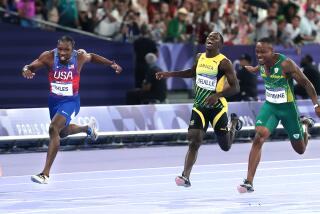Olympic Snafus Vault IBM Into Limelight of an Unflattering Hue
- Share via
A 2-foot-tall boxer took to the ring, as did a 21-foot one. And a Dane and an Australian set new world cycling records--even though the race hadn’t yet taken place.
It all happened at the Olympics, according to a costly computer system built and operated by International Business Machines Corp., which has gone to great lengths to publicize its status as the Games’ official “technology integrator.”
IBM, the world’s largest computer maker, had hoped to dazzle a global audience with judges using laptops, a splashy World Wide Web site and a high-speed electronic network to provide fans and journalists with the latest results.
While many IBM systems have worked fine, repeated failures in some very visible ones have earned the company generally pitiful scores. While implementing such a large and complicated system clearly carried some risks, few expected so many serious problems.
The Olympic Committee’s information system for fans, for instance, at times has been missing large chunks of data, including biographies of medal-winning athletes and transportation schedules.
From Saturday to Tuesday, the Olympics’ popular Internet site periodically did not have any results. And, perhaps most significantly, several software errors have prevented the media from receiving accurate and timely scores--and when reports do arrive, they sometimes contain absurdities like the 2-foot boxer. In some cases, the problems have led newspapers to omit box scores and other data.
“There is no other way to interpret this but as a disaster,” said Mark Stahlman, president of New Media Associates, a New York market research firm. “IBM got the job because they said they could combine computers and networks on a large scale and, thus far, they haven’t met expectations. . . . The public relations issue here is very significant.”
After weathering massive losses and big layoffs in the early 1990s, IBM has staged an impressive comeback over the last couple of years. Many of its ads stress its reliability and technical expertise. IBM executives Wednesday were contrite.
“Our performance in the early days of the Olympics to the wire services was unacceptable to them and to us and to the people of Atlanta,” spokesman Fred McNeese said.
McNeese said company technicians have narrowed the problems down to software glitches in the machines that maintain all the results data. Transmission delays appear to be related to slower-speed equipment used by some news organizations.
IBM spent three years designing the Atlanta systems. The scoring network is supposed to take results, which are typed into laptop computers by judges and scorers, and display them on scoreboards and send them to a central processing facility. From there the information is sent to a variety of sources, including the news media center and kiosks for fans.
For those unable to attend, IBM also created a complex Web site. It was designed to give results, provide information about the athletes and allow people to purchase tickets and souvenirs.
But problems began almost as soon as the competition started on Saturday. The first day, the computer network serving the media began spewing out schedules of the next day’s events while delaying information about who had won medals in that day’s competition.
“It’s been a royal nightmare,” said Ian Love, sports editor at United Press International, one of 12 news organizations that receive results data, which they then disseminate to newspapers and radio and television networks. “It’s missing information. Some of it’s wrong. A lot of it is late.”
By Monday, IBM was resorting to printing out results on paper after each event and faxing them to the media center, where runners deliver them to the 12 subscribers’ offices. In some cases, they are manually typed into computers again.
“It’s gotten pretty low-tech,” Love said.
Despite some improvements Wednesday, problems remained. When one reporter tried to pull up a biography of sprinter Carl Lewis on Wednesday afternoon, the words “No Information Found” flashed on the screen.
Last night, Associated Press, one of the news organizations that receive the computerized results, said it and other news agencies are implementing a backup plan to report all track and field results directly to AP, effectively bypassing the IBM system.
IBM began providing computer systems to the Olympics in 1984. McNeese said the company tested the Atlanta results-distribution system at other, smaller events, such as the U.S. Open tennis tournament, but never at anything as large as the Games.
“You can’t create an Olympics to test for an Olympics,” McNeese said. “With a massive operation the size of the Olympics, things will crop up.”
More to Read
Go beyond the scoreboard
Get the latest on L.A.'s teams in the daily Sports Report newsletter.
You may occasionally receive promotional content from the Los Angeles Times.






